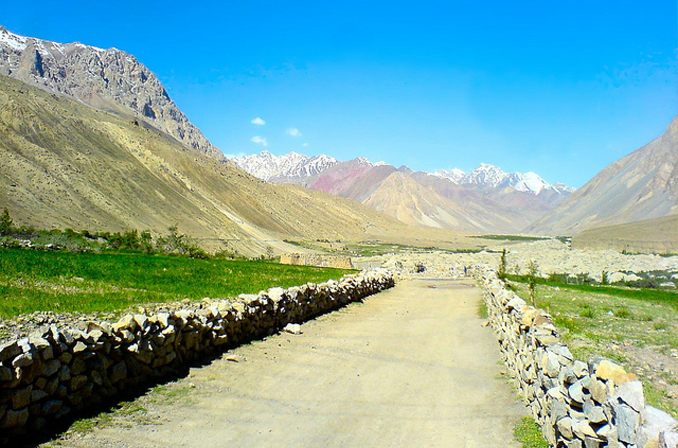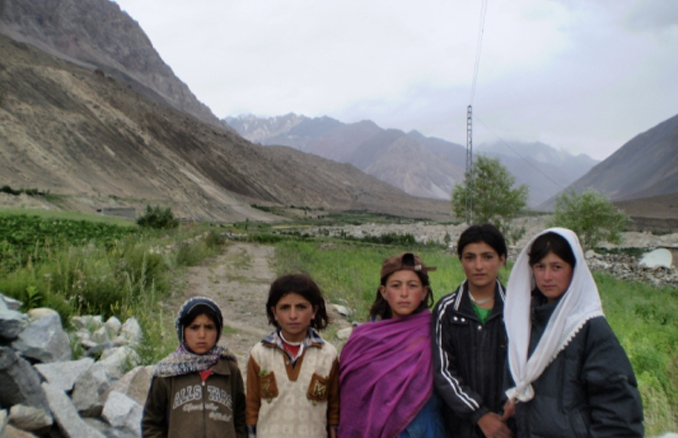Written by: Omer Qayyum and Amna Javed
Posted on: January 23, 2015 | 
Arial view of Sust Dry Port
While travelling along the China-Pakistan Economic Corridor, Sost is the last town on the Pakistani side of the border. Today, we start our journey along the Silk Road from the same town.
This small town holds great significance as it is the center of all trading and commercial activities that take place between China and Pakistan via road link. One of the most prominent landmarks here is the “Silk Route Dry Port”, which was built in collaboration with the Chinese government and has a capacity to handle approximately 400 containers daily.
The immigration and customs offices are also based in Sost, as it is the point of entry into Pakistan. Best described as tiresome and lengthy, the clearance process at these offices needs considerable improvement. In addition to that, the area also lacks basic facilities of clean water and healthcare. A single PTDC Motel caters to the needs of traders and tourists, which is clearly insufficient. The situation presents ample opportunities for improvements including the automation of offices, as well as the establishment of quality restaurants, rest areas, water filtration plants and basic health care units to improve the travelers’ experience.
 |
Chapursan Valley |
Numerous money transactions are made in this town every day for it is the epicenter of Pak-China trade. This highlights that the area holds great potential to foster the banking industry, which could in turn make money matters quicker and more convenient for all travelers.
Keeping in view the development of the China-Pakistan Economic Corridor, improvements in basic infrastructure facilities and provision of essential amenities would drastically increase the current volume of bilateral trade between the two countries. The authorities may also find it worthwhile to revisit their taxation policies, which would increase revenue collection without hampering trade volume.
In addition to commercial and trading activities, Sost and its surrounding areas hold great potential for developing the tourism industry. The attractive yet unexplored Chapursan Valley is located west of Sost and runs parallel to the Afghan border. An adventurous forty-five minute jeep ride from Sost takes tourists to the first village of the valley. Upon entering the valley, the snow-capped mountains, mighty glaciers and fresh water fountains leave the visitors mesmerized with their beauty. Consisting of twelve villages, the valley hides picturesque meadows that encompass small treks and bring into view scenic Rock Springs and green pastures laden with a variety of flowers. The exceptional beauty of the valley makes it a paradise for trekking lovers. Besides this natural beauty, the valley has a blooming cultural atmosphere that the visitors are sure to enjoy.
 |
Chapursan Valley |
Rocks found in the valley contain precious minerals such as quartz, coal and crystals. More valuable minerals can be explored in the area by involving geologists and using modern exploration techniques. Provision of basic facilities and infrastructure would significantly boost the local tourism industry. Presently, the area has no restaurants or hotels to cater to tourists who are forced to carry their food supplies with them. However, it is imperative that the development taking place is environmentally friendly in order to keep the scenic beauty of the valley is preserved in its original form. The sites in this valley can attract mountaineers from across the globe, but due to a lack of facilities for tourists, the potential of the valley still remains unexplored.
As per estimated figures, Sost Dry Port alone has a tax potential of Rs. 4 Billion.
Pastures of Chapursan Valley contain natural herbs that can cure many diseases including jaundice, as well as several eye infections.
Do you know which place in the Northern Areas boasts one of the highest literacy rates? Read the next article in this series to find out.
You may also like: